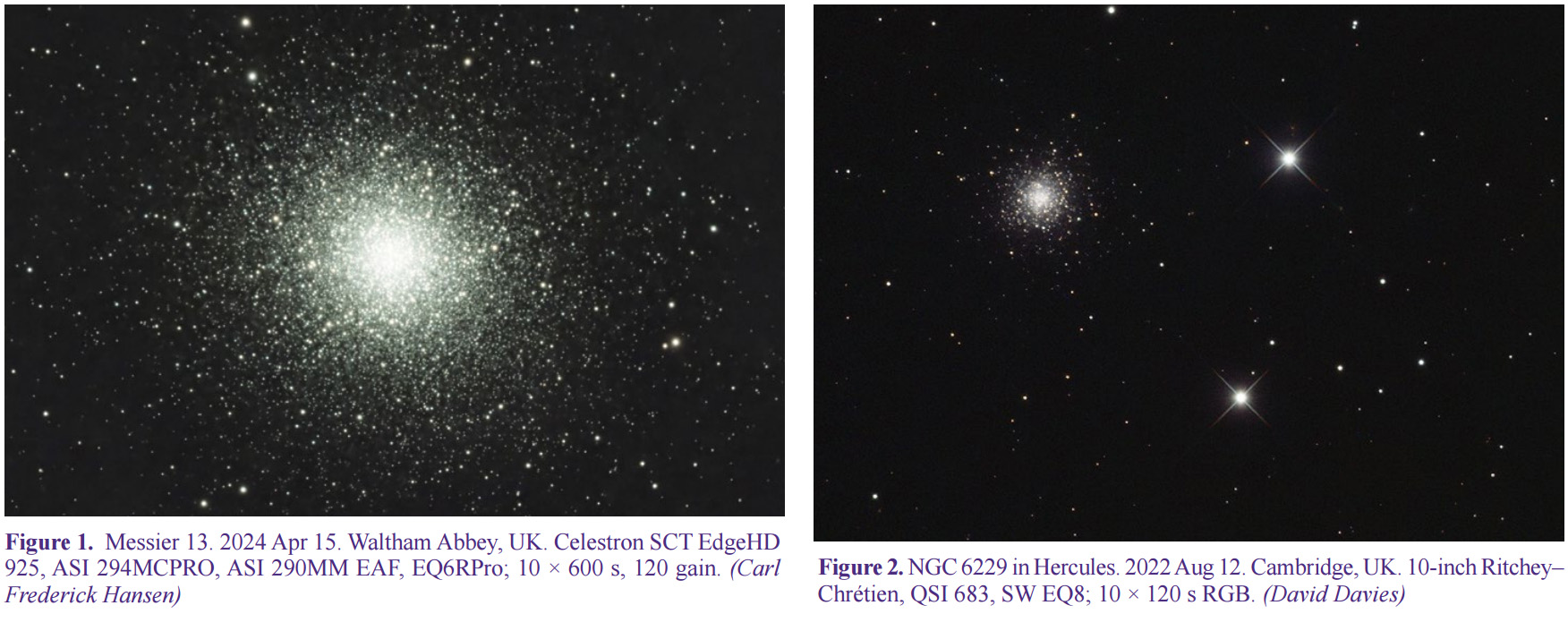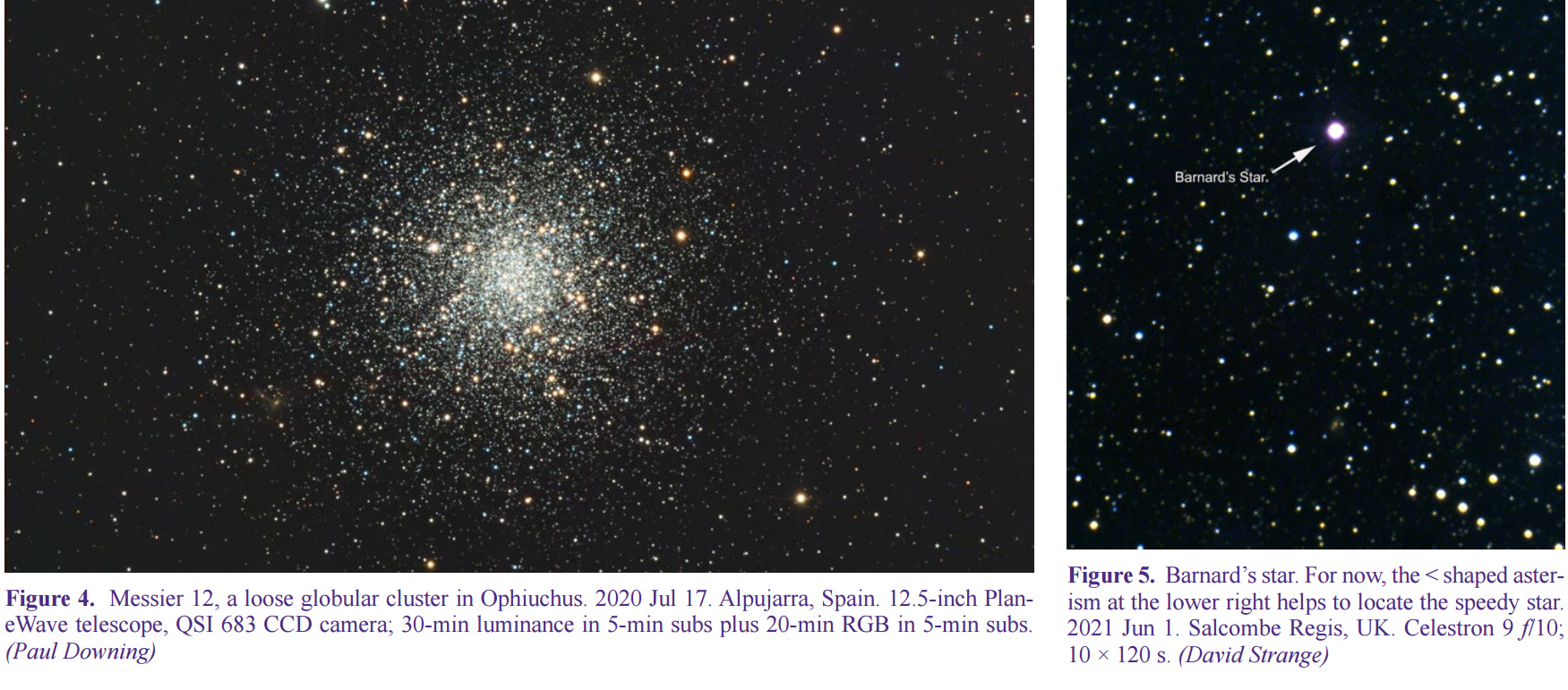Sky notes for 2024 June & July
2024 June 1

(Written for 23:00 BST in the UK on July 1)
With the summer solstice on Jun 20, we reach midsummer and the shortest night of the year. The window for observation shrinks through June and to add to the difficulties, the planetary scene remains unsatisfactory with all the major planets either tucked behind the Sun, or low in the predawn sky. However, it is still worth watching out for the elusive noctilucent clouds, often at their best either side of midnight in this season. By the end of July, it becomes clear that the nights are drawing in and our solar-system quarry becomes a little less shy.
Deep sky
As the sky darkens at around 23.00 BST, the two brilliant northern-hemisphere gems are first to appear and show strikingly contrasting tints. Arcturus (alpha Boötis) and Vega (alpha Lyrae) are the fourth- and fifth-brightest stars in the heavens; Vega an ice diamond, Arcturus an imperial topaz.
Between these luminaries lies the less distinctive pattern of Hercules, the legendary strongman. He is head-to-head with another giant, the fabled healer Ophiuchus. Neither constellation shape immediately pops out, but the area is well worth exploring for its high-surface-brightness deep-sky objects, a major factor during the bright nights of midsummer.

The best known of these is the ever-popular Great Hercules Cluster (Messier 13, or M13), one of the summer’s finest sights, and arguably the most spectacular globular star cluster in the northern hemisphere. To find it, locate the trapezium of third-magnitude stars between Arcturus and Vega known as the ‘Keystone’ asterism, whose western stars are eta and zeta Herculis. Just south of eta lies M13 (Figure 1).
North of the Keystone lies another fine globular, M92, that is somewhat in the shadow of M13 but superb in its own right. A third globular in Hercules is of great interest, not because it is especially spectacular, but because of its position. NGC 6229 (Figure 2) is very distant, an outlier in comparison with most other galactic globulars. It is surprisingly bright for a cluster 100,000 light-years from us, shining at magnitude 9.4, and its small diameter of 4.5 arcmin gives it a high surface brightness. Thought to be a planetary nebula on its discovery by William Herschel in 1787, it was interpreted as a comet by Pons in 1819. It clearly was not, but its starry nature was only described by d’Arrest in 1856; he called it a ‘very crowded cluster’. Huggins’ spectroscope clinched it in 1866, revealing its continuous spectrum. It lies 40 arcmin north-northeast of 52 Herculis and forms a neat triangle with a pair of 8th-magnitude stars.

NGC 6210 (Figure 3a) is a neat planetary nebula northeast of beta Herculis. The 9th-magnitude object is compact at ~40 arcsec in diameter, and bluish in tint so reasonably easy to spot, although detail is elusive visually. T. W. Webb and J. Herschel both described it as ‘an unfocused star,’ and even images reveal a messy blob. Its nickname, the ‘Turtle Nebula’, becomes clear when viewing the four jets visible in hydrogen-alpha in the Hubble Space Telescope (Figure 3b) image.
South of Hercules lies Ophiuchus, if anything more difficult to decipher than the former. There are two streams of 2nd- and 3rd-magnitude stars trailing from northwest to southeast, the more easterly being the more prominent, beginning at Rasalhague, the ‘head of the snake holder’ (alpha Ophiuchi), passing through Cebalrai (beta Oph) and Muliphen (gamma Oph), and ending in nu Oph.

The western stream is fainter and runs from Yed Prior (delta Oph), via Yed Posterior (epsilon Oph), then to zeta and Sabik (eta Oph). Within this pattern, it is fun to track down the many second-division globular clusters which are a varied bunch, from the fairly compact M10, the looser M14, and the distinctly messy M12 (Figure 4) in the northern part of the constellation, to the four Messier globulars further south. Once the Messiers have been mastered, try to find the fourteen NGC globulars in Ophiuchus.
Just to the southeast of Cebalrai is a neat asterism that was briefly a constellation. The Little Bull of Poniatowski was introduced by the Lithuanian-Polish astronomer and mathematician Marcin Poczobutt in 1777 as a tribute to King Stanislaus Poniatowski of Poland, and consists of a V-shaped group of 4th- to 6th-magnitude stars (66, 67, 68, 69, and 70 Oph). It never deserved constellation status but remains useful as a guide to some interesting attractions nearby. Firstly, 70 Oph is a relatively speedy binary star for moderate-aperture telescopes and easily found on the eastern aspect of the Little Bull at 4th magnitude. The components are magnitude 4.2 and 5.9 and show an enjoyable colour contrast, although observers’ descriptions vary. The period of the pair is just over 88 years, and their separation varies from 6.7 to 1.7 arcsec; it is currently widening and will reach maximum later this decade. Half a degree northwest of 66 Oph is Barnard’s star (Figure 5), at 6 light-years the 4th nearest to our Sun and with a proper motion that can be followed quite easily as it speeds north at 10.3 arcsec per year. As a 9th-magnitude red dwarf a telescope is needed to see it, but its passage can be noted over a mere decade.
Two splendid but under-reported binocular targets in the northeast of Ophiuchus on the border with Serpens Cauda are the open clusters NGC 6633 (top, p.226) and IC 4756, the latter known as Graff’s cluster. The pair are 3 degrees apart and have been dubbed ‘Tweedledum and Tweedledee’. Although they are not really that twin-like, both are quite rich and large and best viewed in large binoculars. NGC 6633 is to the west in Ophiuchus and 20 arcmin across, its 40 or so stars combining to shine at 4th magnitude. IC 4756 in Serpens is twice as large but has a similar magnitude. Low-power views are rewarding.
The recurrent nova in Corona Borealis, T CrB, has not erupted at the time of writing but is perfectly placed for regular monitoring, high to the east of Arcturus. In April, it continued hovering around 10th magnitude but could flare at any time this summer.
The solar system
Moon & Sun
Our nearest neighbour scrapes the horizon in midsummer and is generally too low for high-resolution imaging, but is bound to generate the recurrent queries about why it looks so large. There are no eclipses of the Moon during June and July.

The Sun is high in midsummer, and even more care than usual is required to avoid damage to equipment and self. It has been very active during spring, with multiple sunspot groups visible and fine prominences on filtered images (Figure 6).
There are no eclipses of the Sun during June and July.

Planets
The planets remain awkward throughout June and early July.
Mercury is at superior conjunction on Jun 14, then is a difficult evening object, even at greatest eastern elongation on Jul 22. Careful daytime observation will be needed and even if found, the swift messenger is subtending a small disc around 6.8 arcsec.
Venus is at superior conjunction on Jun 4 so not available during that month. On emerging into the evening twilight, it remains very low in the evening even by late July, and thereafter will fail to reach a useful altitude.
Mars begins to emerge into the morning sky in southern Aries but is difficult in strong twilight and faint at +1 through July. Its small disc (around 6 arcsec) may reveal detail to expert imagers, as with Clyde Foster’s superb images from Namibia when it only subtended 4 arcsec (Figure 7, above).
Jupiter follows Mars, lying near Aldebaran in early July and becoming reasonably high in altitude predawn by August. There is a spectacular conjunction of the two planets on Aug 14 & 15, with Mars passing less than half a degree north.
Saturn is the best placed of the planets, although still another morning object, and by the end of July has reached a respectable altitude in eastern Aquarius, being over 30 degrees above the horizon. Its rings are very noticeably less on display than in 2023, being tilted at 2 degrees. To compensate for the poor view of Saturn’s greatest asset, we can now enjoy both hemispheres to the full, and it becomes easier to pick off the family of moons as most stay in the plane of the rings, with only Iapetus playing hard-to-get.
Both ice giants are compromised by the short nights, although Neptune is reasonably high in southern Pisces. Uranus moves into the predawn sky ahead of Jupiter in June, then lies to the west of a line from Jupiter through Mars by July’s end. There is a close brush with Mars in mid-July as the Red Planet rushes past to its south.
Minor & dwarf planets
The dwarf planet (1) Ceres is at opposition in Sagittarius on Jul 6. Although magnitude 7, its low altitude in a rich Milky Way location will make identification tricky.
Comets
The two comets of note are both difficult too. C/2023 A3 Tsuchinshan–ATLAS (Figure 8) may survive its perihelion in September and become a fine sight in the autumn. There is a chance to catch it in early June in western Virgo. It should be around 9th magnitude before being lost in late June.

For more information, see the BAA’s Comet C/2023 A3 (Tsuchinshan-ATLAS) Observing Campaign web page, authored by Nick James, which can be found at bit.ly/4aEDoMX.
Comet 13P/Olbers is brighter but so low in the northwest at dusk that it will be difficult to spot. A good northwestern horizon will be essential.
Meteors
The Boötids peak on Jun 27, when the Moon is at last quarter. Look for any enhanced activity that might occur as in 1916 and 1998. These slow meteors derive from comet 7P/Pons–Winnecke.
The Alpha Capricornids should not be affected by the waning crescent Moon during their peak activity on Jul 30. These often-colourful meteors, while infrequent, can be bright, and a fireball may occasionally occur. The shower is now thought to derive from periodic comet 169P/NEAT.
The Southern Delta Aquariids should be very favourable at maximum on Jul 31, as there is little lunar interference. It is worth looking for them several days either side of maximum as there can be a steady stream of faint meteors. The shower may be derived from comet 96P/Machholz, discovered in 1986.
| The British Astronomical Association supports amateur astronomers around the UK and the rest of the world. Find out more about the BAA or join us. |
